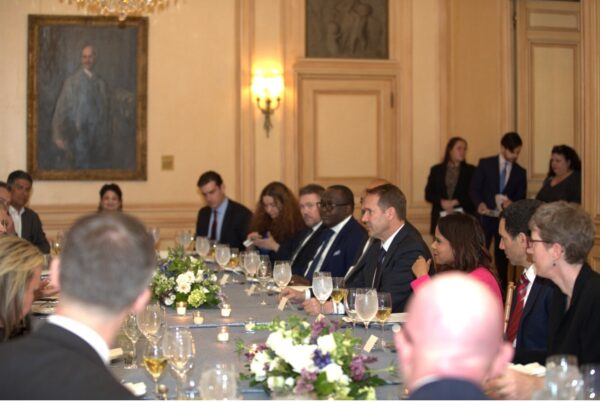Critical Mineral Security: Insights from Meridian’s Global Dialogue Series Dinner

Against the backdrop of intensifying geopolitical competition and a global scramble for clean energy resources, Meridian convened senior U.S. government officials, foreign diplomats, and private sector leaders for a Global Dialogue Dinner on Monday, April 28, 2025, focused on the strategic landscape of critical minerals.
Held in partnership with KoBold Metals, the dinner featured KoBold Co-Founders Dr. Josh Goldman, President, and Dr. Kurt House, Chief Executive Officer, as guests of honor. The Honorable Troy Fitrell delivered special remarks, Senior Bureau Official for the Bureau of African Affairs at the U.S. Department of State.
Presiding on behalf of Meridian was Deborah Lehr, member of the Meridian Board of Trustees and Vice Chairman and Executive Director of the Paulson Institute. The discussion was moderated by Dr. Gracelin Baskaran, Director of the Critical Minerals Security Program at the Center for Strategic and International Studies.
While much has been written on the urgency of supply chain diversification, the conversation focused on the subtler realities of implementation: from the uneven pace of U.S. financing tools to the political calculus of host governments and whether democracies can move at the speed of competition.
These Were the Top Takeaways from the Program:
1. Private Sector Innovation Anchors U.S. Competitiveness
In contrast to more centralized industrial strategies, the U.S. model—anchored in private sector innovation—was positioned as a strategic advantage, not a liability. American firms are leveraging artificial intelligence to solve the sector’s core information problem: predicting high-grade mineral concentrations and optimizing discovery paths. KoBold Metals’ AI-driven discovery model exemplifies how data and predictive modeling can compress timelines and reduce risk. This technological edge is not just about efficiency but about locking in a strategic differentiator that competitors cannot easily replicate.
2. Regulatory Speed Becomes Competitive Currency
Global competition in critical minerals is not just about access or capital but time. While Chinese-backed ventures often deploy resources at remarkable speed, U.S. projects remain constrained by regulatory hurdles that can delay progress for decades. The well-worn observation that “Western investors bring notebooks; Chinese investors bring checkbooks” still resonates. Participants emphasized that closing this gap does not require outspending China but accelerating U.S. permitting and interagency coordination. The Trump Administration’s April 24 Executive Order, Unleashing America’s Offshore Critical Minerals and Resources, aims to do just that, directing agencies to fast-track offshore exploration under existing authorities—signaling a shift toward more agile regulatory practices.
3. Strategic Statecraft Requires Ecosystem Building
Long-term influence in resource-rich regions cannot be won through transactional deals alone. Instead, sustainable impact depends on building strategic ecosystems—integrated efforts that combine infrastructure investment, good governance support, and transparency safeguards. African governments expect more than extraction: they seek jobs, skills training, and local value creation. Trust is forged not through summits or press releases but through a visible and sustained U.S. presence on the ground.
4. Rethinking U.S. Investment Posture
The contrast between Western and Chinese investment styles remains stark. But the U.S. is redefining its global investment posture, moving from an assistance-led development model to one centered on commercial partnership and private capital mobilization. This pivot, discussed as a hallmark of the Trump administration’s strategy, aligns diplomatic and commercial priorities to unlock private capital and foster durable influence and mutual prosperity. The conversation highlighted the growing role of U.S. government agencies in risk mitigation, from the U.S. Export-Import Bank to the Development Finance Corporation (up for reauthorization in 2025), is seen as crucial to operationalizing this investment-first approach.
5. DRC Is a Test Case for Values-Based Investment
The Democratic Republic of the Congo (DRC)—which holds the world’s largest cobalt reserves—is emerging as a key test of the U.S. approach to aligning private capital with strategic and ethical imperatives. At the dinner, participants noted KoBold Metals’ bid for the Manono mine, a high-grade lithium deposit currently co-owned by Chinese interests, as emblematic of this shift: leveraging American innovation and financing to compete with entrenched Chinese positions. Meanwhile, Massad Boulos, the U.S. Senior Advisor for Africa, has played a central role in discussions around a potential minerals-for-security agreement with the DRC government—seeking to pair regional stability with responsible resource development. While the strategy signals a shift toward more integrated U.S. engagement, participants noted the complexity of aligning commercial ambition, geopolitical competition, and on-the-ground realities in a region as dynamic as the DRC.
This program was made possible through the support of
Project summary
| Critical Mineral Security: Insights from Meridian’s Global Dialogue Series Dinner | |
|---|---|
| Impact Areas: | Business and Trade |
| Program Areas: | Diplomatic Engagement |
| Partners: | Private Sector |

